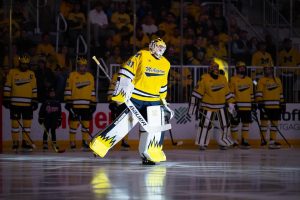Journalist tells of the power of politeness for science writers
May 9, 2019
Last Wednesday, May 1, Union students were able to participate in a science writing workshop with science writer Kat Eschner. The workshop, held in the Phi Beta Kappa room, was well attended. Students and faculty filled the space to learn more about the skills needed to write about scientific topics for a general audience.
Eschner is a regular contributor for “Popular Science,” writing articles on subjects ranging from garbage heaps in Canada to CRISPR gene trials to fungal “superbugs.” She also works as a freelance writer, with pieces published in outlets such as CNBC and “Canadian Wildlife.”
Eschner walked students through her path to science writing during the common hour workshop. Hearing that a well-known science writer majored in history and had a background in political journalism surprised several members of the audience. Eschner explained that her job is to be an expert in communicating science, not an expert scientist.
According to Eschner, there are two types of science writers: those working in science communication and science journalists. Those in science communication tend to work for universities or large companies and they publicize the recent findings and achievements of their institution to enhance prestige and public engagement.
Science journalists have careers more typical of other types of journalists, with a particular emphasis on topics related to science and health.
Following their introduction to science journalism, students learned about “news value.” Eschner explained that while some scientific advances may be fascinating and noteworthy within their field, the implications of the research may not interest readers. Eschner said that choosing articles with news value and emphasizing the importance of this research guides her as she chooses topics to write on.
To illustrate her creative process, Eschner walked students through her workflow and explained how to find an intriguing story. She showed students the initial press release that prompted her recent article on microbial toxins found in E-Cig liquid.
After determining the “news value” of the piece, Escher explains that she delves far deeper into the material. The highly curated press releases that are published by universities can be one-sided, explaining the breakthroughs of the work but not its drawbacks. She explained the importance of reading primary scientific literature carefully and provided students with a list of critical questions to ask themselves as they reviewed each paper.
Eschner then illustrated the importance of connections and scientific sources. For the article on E-Cigs, she told students that she interviewed both the study first-author and another expert in the field.
“Obtaining multiple perspectives is crucial,” she told the audience. “Someone may think that their research is the best thing ever, while other experts may pose questions about the methods that the authors used, or the conclusions they drew.”
As Eschner emphasized the importance of making connections, she told listeners that it can be difficult at first to find sources and publishers for articles.
She recommended that students interested in science writing develop a solid pitch, a scientific story that they hope to tell, instead of just approaching editors with a vague idea or interest.
Students and faculty were able to ask questions about the pressures of science journalism and learned more about the daily challenges of the work. The difficulty of working under strict deadlines in combination with the need to interact with many individuals of differing schedules led Escher to stress the importance of politeness. She said, “You’d be surprised by how far a politely worded email can get you.”
Students left saying “thank you” for the insight that they had gained into the world of science journalism and their first-hand glimpse at the determination required to write a piece of science writing worthy of publication.






